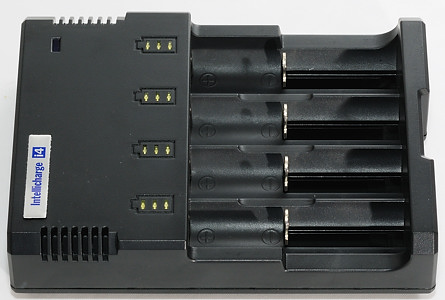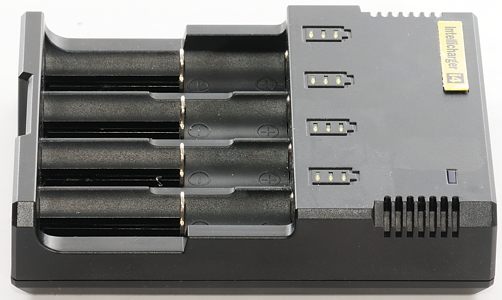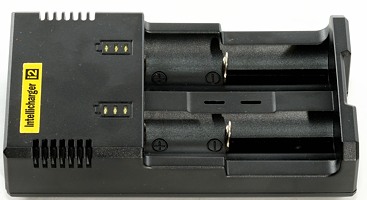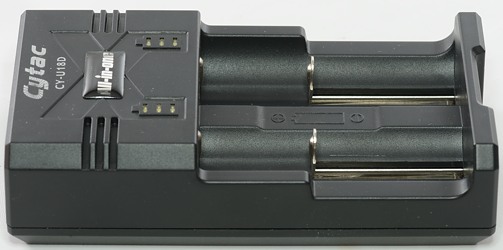Nitecore chargers the i4 family and clones

This is not a review or test, but the history of the i4 charger and clones, based on the chargers I have reviewed. I believe this to be one of the most popular charges around, probably because it is fairly cheap, easy to use and can both charge LiIon and NiMH batteries.
The i4 is a four slot charger, but it only has two charging circuits. This means that it will charge with 0.7A with two batteries loaded and 0.35A with four batteries loaded. The charge circuit is time shared between the channels, this sharing makes it fairly slow with a full load of batteries (About 10 hours).
The charger has build in mains power supply, but can also be powered from an external 12V supply (Like a car).
Click on the pictures to see the reviews of the different chargers.

The first time I test a i4 charger is late 2011, at that time is was branded Sysmax (Owner of Nitecore brand). The charger works, the actual charging was acceptable, but there was some probles:
Mixing LiIon and NiMH did not work correctly, the slots was not independed enough.
The build in power supply was a bit weak, this was mostly a problem in 110VAC countries.
The charger could not handle long batteries.

Nitecore did read my review and started on improving the charger, I did even get a beta version of it to test.
In April 2012 I got the upgraded i4 for review, this time it was branded Nitecore and the slots was increased 2mm in length. The charger was not the best charger on the market, but it was a good universal charger that could handle both LiIon and NiMH batteries and the price was fairly low.

Nitecore made a two channel version of the i4 and called it the i2. I got it in November 2012. This charger has wider slots, this means it can handle 26650 without problems. The current is reduced to 0.5A making it better for 14500 and 16340 batteries, but slower for 18650 and 26650 batteries.
Because the charge current does not vary with the number of batteries I did like this charger better than the i4.

The i4 charger was popular and other brands started to clone it. I reviewed the above charger in April 2013.
The charger has one improvement compared to the i4, there is a switch to select between 3.6V and 4.2V LiIon charging.
Actual charging is about the same as the i4, except there is no trickle charge on NiMH and there is better space for 26650 batteries.

Another clone from Juni 2013, this time from Cytac. This charger does not have anything extra compared to the i2.
Actual charging is about the same as i2, but without trickle charging for NiMH.


In Juni 2014 both i2 and i4 got a refresh, the main visible difference was metal rails, inside Nitecore has packed a lot of the electronic into a single chip. The slots are a bit shorter this time, this can be a problem with 26650 batteries being more common (Protected 26650 are usual long). The LiIon charging is about the same as always, but for NiMH the charger has both voltage and -dv/dt termination.

In August 2014 I got a large collection of chargers from Enova, including some chargers that must have been inspired from the i4.
This 8 channel charger has 8 charging circuits, i.e. it will always charge with full current on all channels. All the slots can handle 26650 batteries and it is also possible to charge a few 32650 in the charger. The actual charge current is about the same as i4 does on a single channel. This charger has usb output that is powered from the 12V input (i.e. it is not a power bank). The charger requires a external mains power supply.
Actual charging is about the same as i4, but without trickle charging for NiMH and always full current for LiIon.

This charger looks very much like the 2 generation i4, but has a 3.6V/4.2V charge voltage switch.
Actual charging is about the same as i4, but without trickle charging for NiMH.

This charger looks very much like the 2 generation i2, but has a usb output and can be used as power bank.
Actual charging is about the same as i2, but without trickle charging for NiMH.


Nitecore has made some more advanced chargers based on the i2 and i4. When powered on these two chargers will charge with the same current as i2 and i4, but using the switches on the chargers it is possible to reduce the current and also select 3.6 volt charging voltage. The display shows a lot of information about the charging, but the chargers are not analyzing chargers.
Notes
When I say charging looks the same, it is not a detailed comparison, but only means that the current levels are similar and they have the time sharing (i4).
Clone: Looks like the orginal, but uses another brand name. This will usual be legal.
Copy: Looks like the orginal including brand name, but is produced by another brand.
Both clones and copies can and often will use a differet circuit inside.
Interesting information, thanks
Thanks HKJ and I assume the same holds true for the i2.
?
Thanks HKJ. Your work is much appreciated.
Out of all these I believe i2 is the best choice for charging performance I guess?
The i4 charging two batteries (0.7A) is faster than the i2 charging two batteries (0.5A).
I see, how about the charging performance on nimh? Is it better than i4 because i2 has lower current?
There is no reason to use a low current, manufacturer recommended charging rate for NiMH is 0.5C to 1C.
For AA both chargers is below that range, for AAA the i4 with two batteries are close to maximum.
Where the i4 is problematic is smaller LiIon batteries, there the i2 is easier to use.
Just got an I4 and first impression is it is having problems only fully charging two out of the four batteries.
You do not specify what you mean by "fully charging", if it is because the battery "only" has 4.15 volt when removed from the charger, you are wrong. That will be fully charged.
thanks HKJ
After charging two show 4.17 and two 4.13 but putting the two 4.13 back in charger will top up to 4.17 never seen this on my five year old cheapo two-bay charger but as a newbie have no idea really about the exact meaning of fully charged.
LiIon batteries will drop in voltage after the charger is finished how much depend on a couple of factors. Some of the factors are battery age and time. I.e. if the 4.17 volt batteries are fairly new and the 4.13 are old it makes sense. When you put them in the charger again you measure a very short time after the charger is finished and get a higher voltage.
The old charger probably never turn off the charge current, this will keep the batteries at maximum voltage and also wear them down.
No problem mixing 4.13 and 4.17 in a flashlight? Batteries are brand spanking new but will need to do some more testing to learn the noble art of charging ![]()
In parallel no, but in series it can be a problem.
Nicely done hkj. Comparison extravaganza. TY.
Yes, excellent comparison study! Thank you for it!